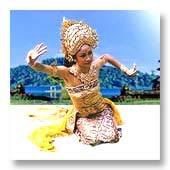Bali history. There is no trace of the Stone Age in Bali although it's certain that the island was already populated before the Bronze Age commenced there about 300 BC. Nor is much known of Bali during the period when Indian traders brought Hinduism to the Indonesian Archipelago. The earliest records found in Bali, stone inscriptions, date from around the 9th century AD and by that time Bali had already developed many similarities to the island you find today. Rice was grown with the help of a complex irrigation system probably very like that employed now. The Balinese had also already begun to develop the cultural and artistic activities which have made the island so interesting to visitors right down to the present day.
Hindu
Hindu Java began to spread its influence into Bali during the reign of King Airlangga from 1019 to 1042. At this time the courtly Javanese language known as Kawi came into use amongst the royalty of Bali, and the rock-cut memorials seen at Gunung Kawi near Tampaksiring are a clear architectural link between Bali and 11th century Java. After Airlangga's death Bali retained its semi-independent state until Kertanegara became king of the Singasari dynasty in Java two centuries later. Artists, dancers, musicians and actors fled to Bali and the island experienced and explosion of cultural activities. The final great exodus to Bali took place in 1478.
European
Marco Polo, the great explorer, was the first recorded European visitor to Indonesia back in 1292 but the first Europeans to set foot on Bali were Dutch seamen in 1597. Setting a tradition that has prevailed right down to the present day, they fell in love with the island and when Cornelius Houtman, the ship's captain, prepared to set sail, half of his crew refused to come with him.
Dutch
In 1710 the capital of the Gelgel kingdom was shifted to nearby Klungkung but local discontent was growing, lesser rulers were breaking away from Gelgel rule and the Dutch began to move in using the old policy of divide and conquer.
Independence
On 17 August 1945, just after the end of WW II, the Indonesian leader Sukarno proclaimed the nation's independence but it took four years to convince the Dutch that they were not going to get their great colony Back.












